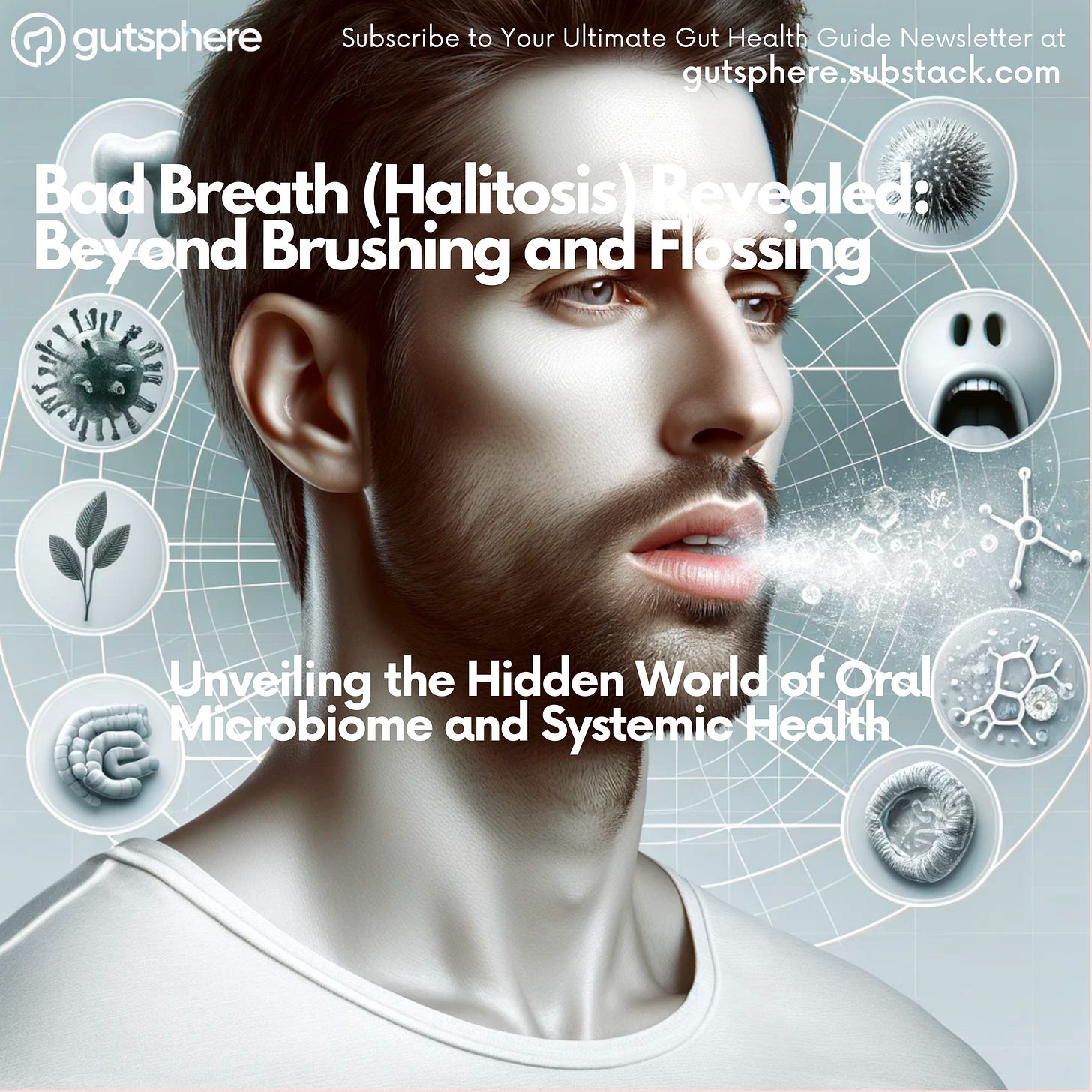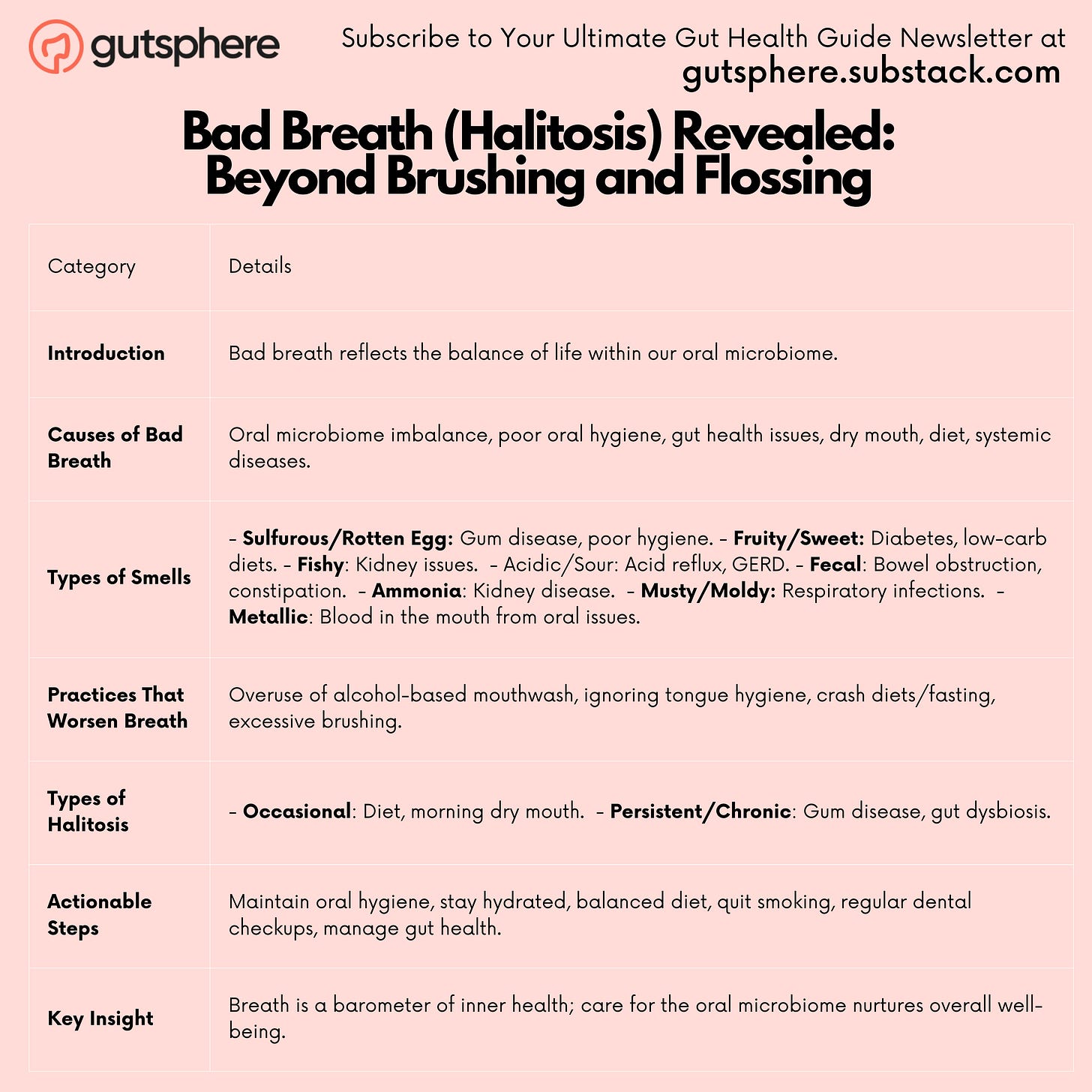Bad Breath (Halitosis) Revealed: Beyond Brushing and Flossing ( Part 1/7)
Unveiling the Hidden World of Oral Microbiome and Systemic Health
Introduction
Our everyday breath, often taken for granted, quietly reflecting the intricate balance of life within us – our oral microbiome.
Most of us, maintaining fresh breath is a routine of regular brushing, flossing, and maybe the occasional mint. We rely on these practices without much thought, believing they are all it takes to keep halitosis at bay.
Recent scientific revelations have shown us that bad breath, or halitosis, is not just a matter of oral hygiene. It's a complex interplay between the billions of microorganisms in our mouths and our overall health, especially our gut.
As we embark on this journey to understand bad breath, we uncover the diverse world of the oral microbiome. This ecosystem, if imbalanced, can lead to the overgrowth of certain bacteria, which produce the unpleasant sulfur compounds responsible for halitosis.
Tackling bad breath becomes a challenge when we realize it's not just about the mouth. Factors like diet, gut health, and even stress play significant roles. These elements can disrupt the microbial harmony, leading not only to bad breath but potentially impacting our systemic health.
The good news is that with new insights, we can take actionable steps beyond traditional oral care. Adjusting our diets to include probiotic-rich foods, staying hydrated, and managing stress can foster a healthier oral microbiome, leading to fresher breath and better overall health.
Armed with this knowledge, we now see our breath in a new light – as a barometer of our inner health. By caring for our oral microbiome, we're not just fighting bad breath; we're nurturing our entire well-being.
Bad Breath (Halitosis): A Comprehensive Unpacking
What is Bad Breath?
Bad breath, or halitosis, is an unpleasant odor emanating from the mouth. It's not just a social concern but can be an indicator of oral or general health issues.
Causes of Bad Breath:
Oral Microbiome Imbalance: Bacteria that produce volatile sulfur compounds (VSCs) are the primary cause of chronic bad breath. These compounds, such as hydrogen sulfide (rotten egg smell) and methyl mercaptan (cabbage-like smell), are by-products of bacterial metabolism in an imbalanced oral environment.
Poor Oral Hygiene: Inadequate brushing and flossing lead to food particle accumulation, which bacteria decompose, releasing foul-smelling gases.
Gut Health Issues: Conditions like acid reflux or gut dysbiosis can contribute to bad breath.
Dry Mouth (Xerostomia): Saliva cleanses the mouth; a lack of it (often due to certain medications or salivary gland issues) can cause bad breath.
Food and Diet: Certain foods, like garlic and onions, and diets high in sugar and processed foods can exacerbate bad breath.
Tobacco Use: Smoking and tobacco products contribute significantly to bad breath.
Systemic Diseases: Diabetes, liver, kidney, and respiratory tract diseases can cause specific types of halitosis.
Some common types of bad breath smells and their possible implications:
Sulfurous or Rotten Egg Smell:
This is commonly caused by bacteria in the mouth that produce volatile sulfur compounds (VSCs). It's often associated with gum disease or poor oral hygiene.
Fruity or Sweet Smell:
A fruity odor can indicate high levels of ketones in the body, which is common in individuals with uncontrolled diabetes or those following a strict low-carbohydrate diet.
Fishy Smell:
A fishy smell can sometimes be a sign of kidney problems, as the kidneys are unable to filter out certain waste products effectively.
Acidic or Sour Smell:
This type of smell can be associated with acid reflux or gastroesophageal reflux disease (GERD), where stomach acids enter the mouth.
Fecal Smell:
A fecal odor can be a sign of a bowel obstruction or severe constipation, where the smell of feces is transmitted to the breath.
Ammonia Smell:
An ammonia-like smell can be an indicator of kidney disease, as the buildup of waste products in the blood (uremia) can produce this odor.
Musty or Moldy Smell:
This type of smell can be associated with certain respiratory infections or conditions, where bacteria or fungi accumulate in the respiratory system.
Metallic Smell:
A metallic smell can be due to blood in the mouth, which could be a result of gum disease, tooth decay, or other oral health issues.
Common Practices That May Worsen Bad Breath:
Overuse of Mouthwash: Regular use of certain mouthwashes containing alcohol or other harsh ingredients can disrupt the delicate balance of the oral microbiome. Instead of eliminating bad bacteria, they can strip the mouth of its protective elements, eventually worsening the breath issue. Scientific studies have shown that long-term use of such mouthwashes can alter the oral microbiome and potentially lead to oral dysbiosis.
Ignoring Tongue Hygiene: The tongue can harbor bacteria and food particles, contributing to bad breath if not cleaned regularly.
Crash Diets/Fasting: These can lead to the production of ketones, which have a strong odor and can cause bad breath.
Excessive Brushing: Over-brushing can damage gums and enamel, potentially leading to oral health issues that cause bad breath.
Types and Frequency of Bad Breath:
Occasional Halitosis: Often related to transient factors like food, poor oral hygiene, or morning breath due to dry mouth while sleeping.
Persistent/Chronic Halitosis: This indicates an ongoing issue, such as chronic gum disease, persistent dry mouth, systemic health conditions, or continuous gut dysbiosis.
Frequency: The frequency of bad breath can be a key indicator. Occasional bad breath is common and usually not a major concern. However, persistent or chronic bad breath warrants a deeper investigation into underlying causes.
Actionable Insights:
Oral Hygiene: Regular brushing, flossing, and tongue cleaning.
Hydration: Drink plenty of water to maintain saliva flow.
Diet: Balanced diet low in sugars and high in fibers, vegetables, and fruits.
Quit Smoking: Eliminating tobacco use can significantly improve breath quality.
Regular Dental Checkups: To identify and treat issues like gum disease or cavities.
Managing Gut Health: Addressing issues like acid reflux or gut dysbiosis with the help of a healthcare professional.
Conclusion: A Journey of Discovery
As we close this chapter on halitosis, remember it's not just about masking odors but understanding and nurturing the complex ecosystem within us. In our next edition, "The Gut-Breath Connection: A Microbiome's Tale," we'll explore how our gut health directly shapes our oral well-being and breath.
Stay curious and connected to your breath, for it holds stories beyond mere freshness, echoing the health of your entire being.
Best regards,
The Gutsphere Team
Request
Share
Our sincere request to you is to share the newsletter with your friends, family, and community so that they can benefit from the content. Also it will help us grow the newsletter, and eventually, as we release more content, digital tools, and more we will enable people around the world to live chronic disease free.
Subscribe
Feedback
Also, please give us feedback so that we can improve the content. And if there are any topics that you want us to cover please send us your questions and topics. Furthermore, if you try any of the things we provided information please share your experience with us.
Thank You
GutSphere Team
Disclaimer
Please note that the information provided in this newsletter is for informational purposes only and should not be considered as a substitute for professional medical advice, diagnosis, or treatment. If you have any concerns or questions about our health, please consult with a licensed healthcare professional. The information contained in this newsletter is not intended to diagnose, treat, cure, or prevent any disease. The publisher and authors of this newsletter assume no responsibility for any adverse effects that may result from the use of the information contained herein.



